BY CHERYL ANDERSON
L’Isle-sur-la-Sorgue is one of the premiere European towns for serious antique buyers—or the casual shopper. The variety of shops there runs the gamut from very pricey and unique to tea towels and sundry. During the area’s two annual fairs, there are over 500 antique dealers and brocante (secondhand) dealers. The fairs are famous in France as well as much of Europe, with its Sunday open-air markets dating as early as November 9, 1596.

Confitures délicieux.

Blocks of French milled soap are a must to buy.
All during the year, of course, the antique shops—some housed within former industrial buildings during a previous incarnation of the town—are open and loaded with beautiful furniture. You can find some truly exquisite pieces. Each Sunday there’s a flea market (Av. des 4 Otages) as well as an antique market—brocante markets are on Saturday and Sunday. An old book market is held on the last Sunday of each month. Around the town are shops selling oils, herbs, and Pastis—it’s Provence after all.
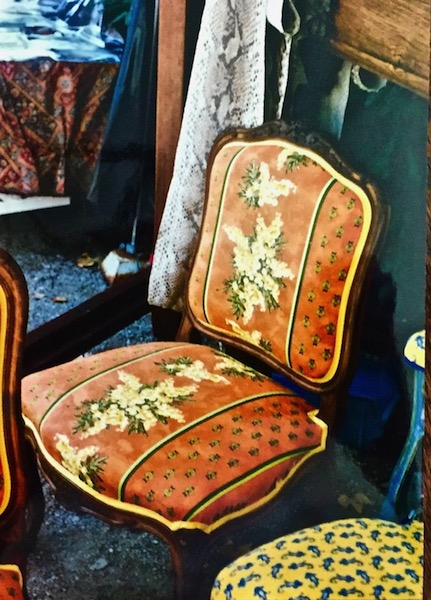
Mimosa motif fabric on this pretty little chair.
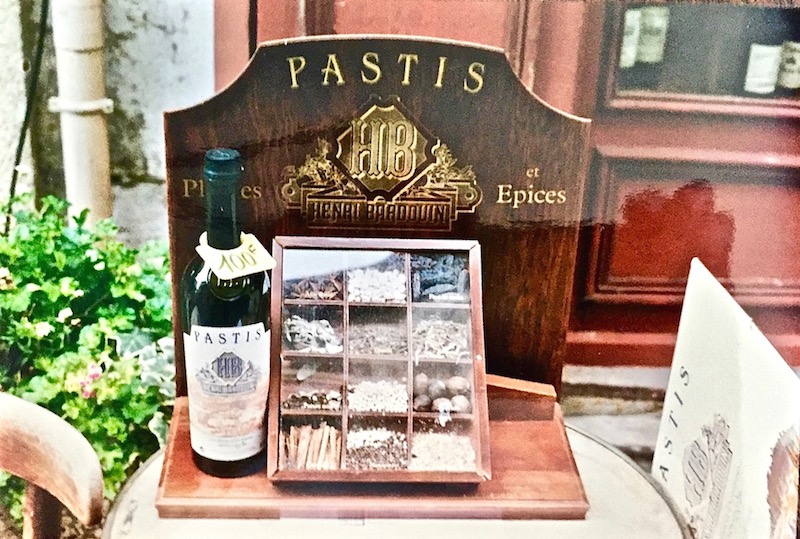
Pastis, a product of Provence.
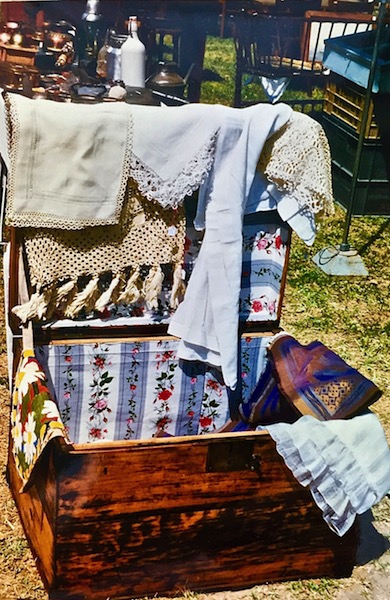
Linens in abundance.
L’Isle-sur-la-Sorgue, which counts Penicuik in the United Kingdom and Anagni, Italy, as its “twin towns,” is located in the Vaucluse in Provence. Insula was the town’s original name, becoming L’Isle-sur-la-Sorgue on August 18, 1890.
First developed in 12th century as a fishing town built on stilts above a marsh, water played such an important role in the town, earning it the aforementioned nickname as the Venice of Provence. The Sorgue River served as a sort of moat around the ramparts from that time until 1795.
By the 18th century, 70 huge waterwheels lined the canals that powered the major industries of paper and silk making—some are still there in working order. I found them charming in appearance and the splashing water a most pleasant sound. Artisanal mills for producing oil, wheat, wool, rugs, and dyeing begin to pop up as time passed.

More brocante sellers than you can count at the August fair.
I first visited L’Isle-sur-la-Sorgue in 1997. My friend Helen had arranged for us to go to its August 15th antiques fair—one of the two large fairs held twice a year (the other is during Easter weekend). August 15th marks the end of summer breaks and all holiday locations empty out until the September tourists arrive. On the Côte d’Azur, the beaches are, for a few days anyway, less crowded. It’s a nice quiet time of year if you are planning to visit and would rather avoid the huge crowds of holiday seekers from around the world.
We took a train from Nice to Avignon, toured the Grande Palais, and walked on the Pont Avignon Bridge that goes nowhere, as it simply ends unfinished. In the tiny town of Pujaut, we lodged in a designated Chambres d’Hôtes-Gites de France called Bon Bambou on Impasse des Bambous. It was my one and only time to stay in a gites, which you’ll find all over France—it turned out to be a very pleasant experience.

Gites oficial.
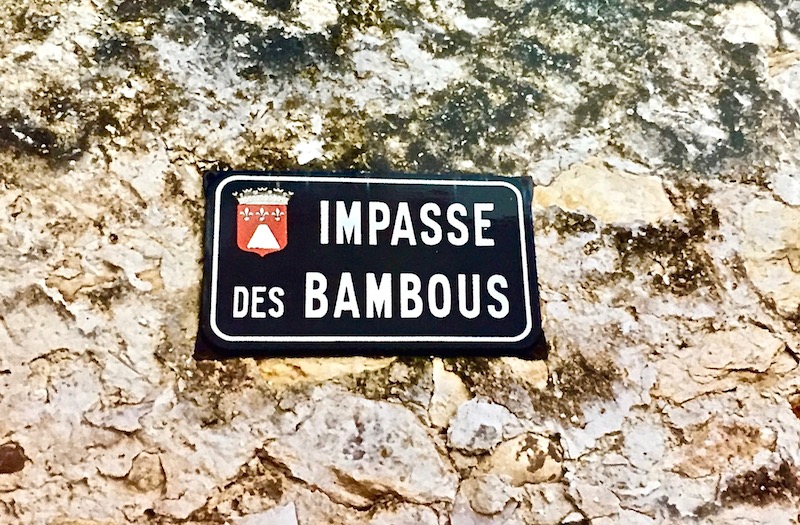
Perhaps this was the sign that inspired the name Bon Bambou.
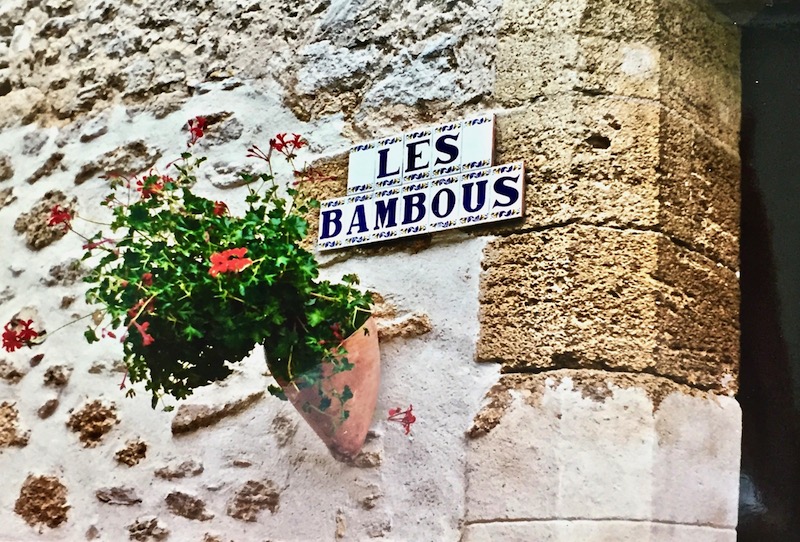
Another source of inspiration?
In the town of L’Isle-sur-la-Sorgue, there’s a park on the river with a waterwheel close by. Stop in one of the many cafés for a drink or snack, watch the people, walk across the little bridges, slowly meander along the ancient narrow streets imagining what life was like centuries ago. The tourist office is on Place de la Leberté (+33 (0) 4 90 38 04 78), where they have a list of antique shops and museums—or you may simply wander around and stop in those shops you discover have something you cannot live without.

Sacs de pain made from colorful Provençal fabric.
If the small clay Christmas figures known as Santons, made in Provence, interest you, there is a museum filled with them. For old tools, the Saint-Antoine museum is where you’ll find them, and there’s even a museum of puppets and toys from 1880-1920 (26 rue Carnot). Notre-Dames-des-Anges built in the 17th century, has a clock showing the time, date, and phases of the moon and a delightfully ornate interior.
Hôpital (pl des Freres Brun) houses a rare collection of Moustiers faience. I’ve written about Moustiers in a previous dispatch. Inside the Hôpital, with its Baroque interior, there’s a grand staircase, chapel, and pharmacy. Ask at the reception desk to view the old fountain in the garden.
There are also mansions that have been turned into art galleries, such as the fantastic Maison René Char, also known as Hôtel Donakdeï de Campredon, which houses works of art by Miró, Maugin, Dufy, Picasso, a collection of manuscripts, and objets d’art. Char was a friend and associate of artists and writers like Albert Camus, Georges Bataille, and Maurice Blanchot.
Open Saturday to Monday, Le Village des Antiquaires de la Gare (2 bis av. De l’Egalite) is one of the largest antique villages along the main road of the old mills and factories. It houses approximately 110 dealers inside an old weaving factory. Find the eastern edge of the town, and there you’ll see a great view over the river.

Signs for just about everything.
Antique shopping is the perhaps the primary reason people visit L’Isle-sur-la-Sorgue, but as you can see, there are other points of interest—from tools to Santons. I was there in August and it was hot, but the splashing sounds from the waterwheels, the shade of the park, and many stops for a cool refreshing beverage, together made for a most enjoyable day in Provence.
Bonne Vacance!






